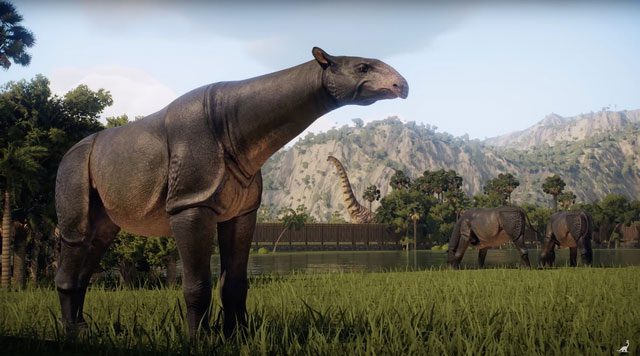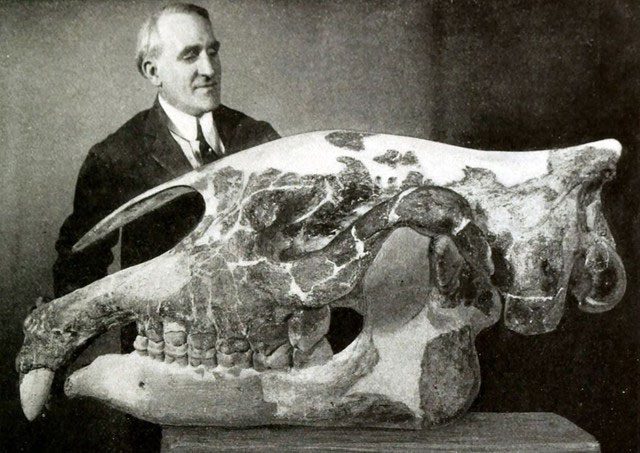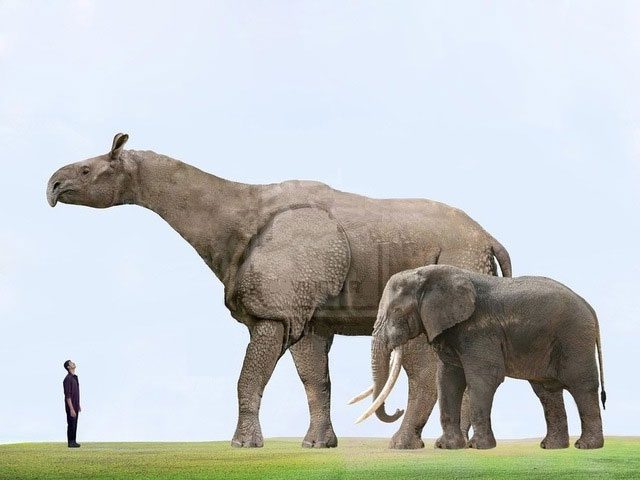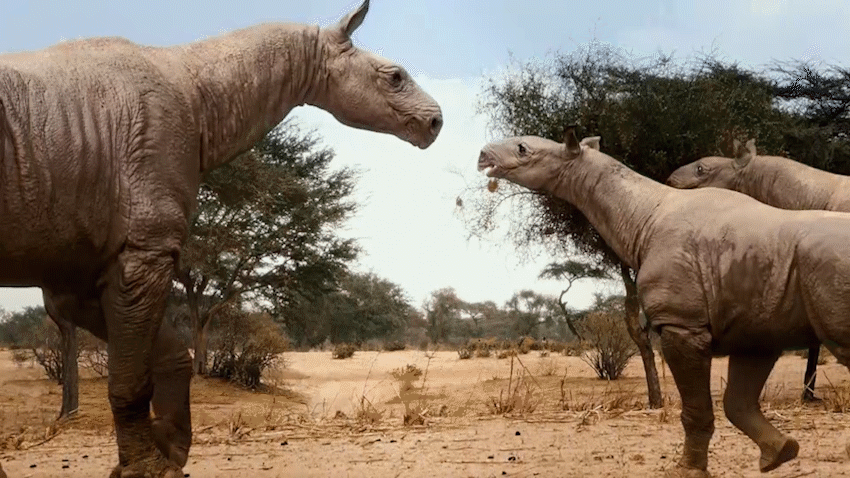Paraceratherium, also known as Indricotherium, is the largest land mammal ever known. Its colossal size makes it one of the most impressive creatures to have ever walked the Earth.
The fossil remains of Paraceratherium reveal it to be an animal of almost unimaginable size. Its skull alone measured over 1.3 meters (4.3 feet) long. Instead of horns like modern rhinos, Paraceratherium had a dome-shaped forehead and a notably elongated nasal cleft, suggesting it possessed a prehensile upper lip or that this lip had muscular features similar to those of an elephant’s trunk.

Paraceratherium stood about 5 meters tall at the shoulder, longer than two large pickup trucks, and weighed around 15-20 tons—equivalent to four African elephants. This giant beast was a relative of modern rhinos, roaming the Earth millions of years ago during the Oligocene epoch, approximately 34–23 million years ago.
Regarding its diet, the teeth of Paraceratherium were low-crowned yet incredibly robust—some molars were the size of a human fist! This indicates that they typically stripped leaves and branches from trees, requiring a massive intake of vegetation to support their enormous bulk.
Estimates of the size of this creature vary considerably in scientific studies, but most researchers believe that Paraceratherium stood at least 4.8 meters (15.7 feet) tall at the shoulder—much taller than a single-story building! Its pillar-like legs were equipped with sloping feet, each foot measuring up to half a meter (20 inches) long. Notably, the limb bones suggest that Paraceratherium descended from much smaller and faster ancestors among early rhinos.

Paraceratherium was a herbivore, feeding on leaves, branches, and fruits. Its enormous height allowed it to access food sources that other animals could not reach.
Recently, paleontologists have discovered fossils of a new species of Paraceratherium named Paraceratherium linxiaense, or the “Linxia Giant Rhino,” in northwestern China, representing the largest land mammal that ever existed on Earth. The complete skull and jaw fossils analyzed by a Sino-American research team indicate that this giant rhino weighed around 24 tons, stood over 4.9 meters (16 feet) tall at the shoulder, had a head longer than one meter (over 3 feet), and a body measuring nearly 8 meters (26 feet)—equivalent to the combined size of 5-6 elephants.
The Linxia Giant Rhino lived about 31 million years ago in the northern Tibetan Plateau before migrating southwest, with fossils also found in Mongolia, Kazakhstan, Pakistan, and Eastern Europe during the Oligocene epoch.

Paraceratherium had close relatives among today’s rhinos. However, they were significantly larger and lacked horns. Paraceratherium possessed a neck measuring 2 to 2.5 meters (6.6 to 8.2 feet) long, enabling it to easily reach high treetops for feeding.
During that time, the largest land predators were typically no larger than modern wolves, meaning that an adult Paraceratherium had little to fear except for extremely unlucky encounters with large crocodiles. However, young individuals could still be vulnerable to predation. With its enormous size, long lifespan, and unrestricted range of habitats, Paraceratherium was considered a dominant species at the top of the food chain during the Oligocene epoch.

Mammoths, which are regarded as some of the largest mammals, weighed only about 6 tons (13,200 pounds), significantly smaller compared to Paraceratherium. Some sauropod dinosaurs, such as Argentinosaurus, may have been longer than Paraceratherium, but Paraceratherium was considerably heavier. Paraceratherium became extinct by the end of the Oligocene, possibly due to climate change or competition from other mammal species.
So how did these super beasts ultimately go extinct after thriving for about 11 million years? The exact cause remains a paleontological mystery. Perhaps competition from newly emerged trunked animals like gomphotheres contributed to changes in the habitat and food sources of Paraceratherium. The rise of more efficient predators in the early Miocene, along with cooler climates and shifts in vegetation, may have ultimately led to the extinction of this species. One thing is certain: the disappearance of Paraceratherium marked the end of an era for extremely large land mammals.

Paraceratherium was a colossal and remarkable creature that dominated the Earth during the Oligocene epoch. Its immense size and unique lifestyle make it one of the most fascinating mammals to have ever existed.
With new fossil discoveries still being carefully excavated, our understanding of Paraceratherium continues to evolve and expand. There are countless questions that remain regarding the behavior, biology, and eventual extinction of this animal. However, Paraceratherium undoubtedly holds the heavyweight championship in the realm of large mammals. But who knows? Perhaps a future excavation will uncover an even larger competitor!




















































